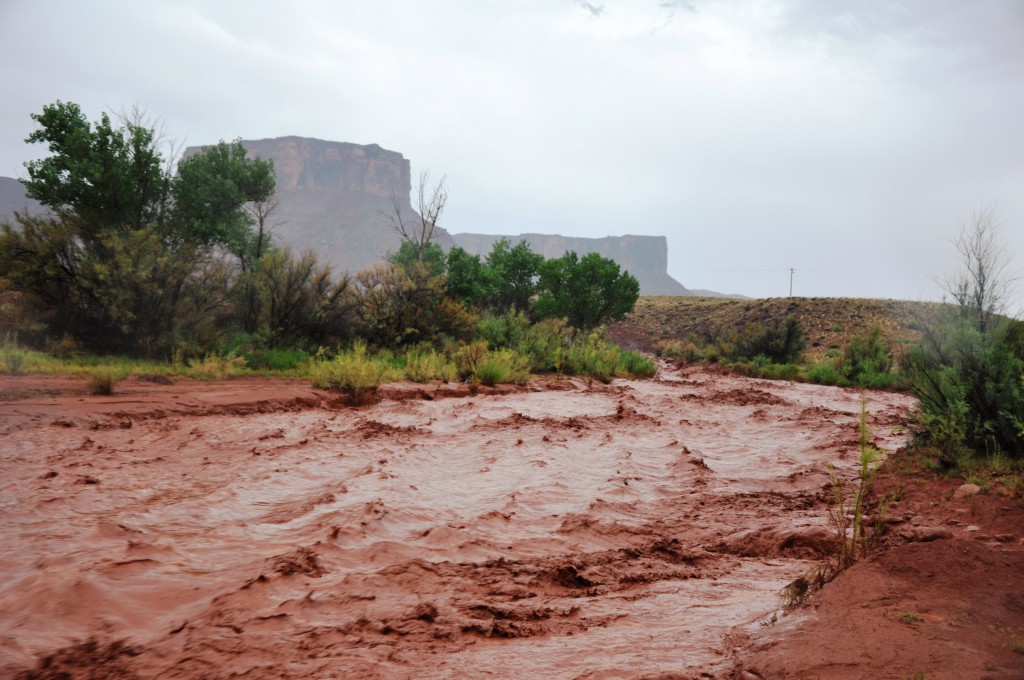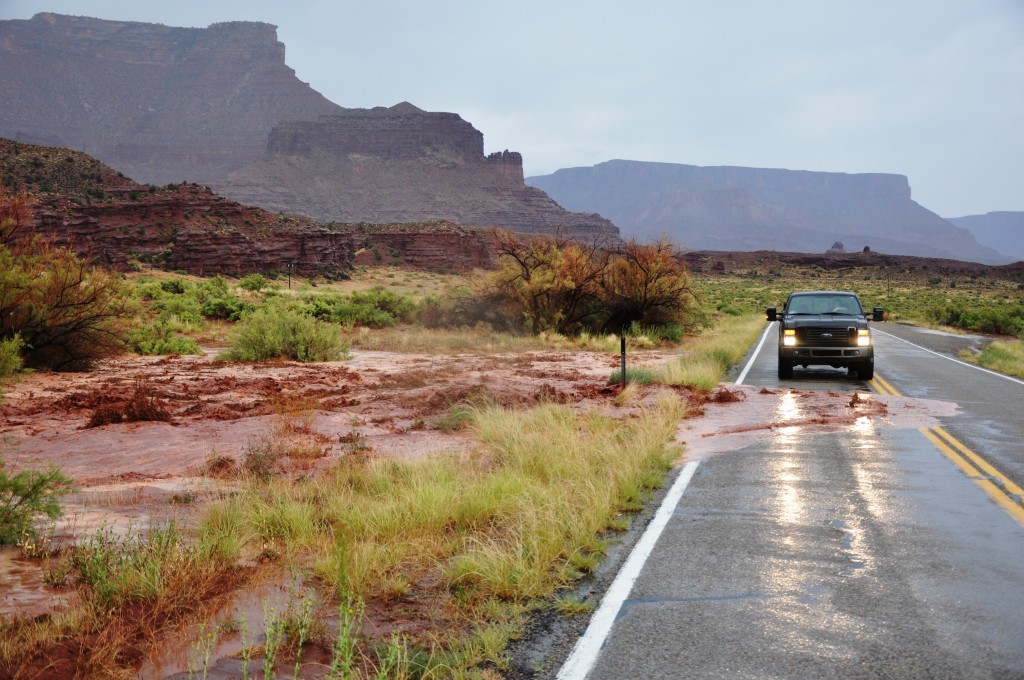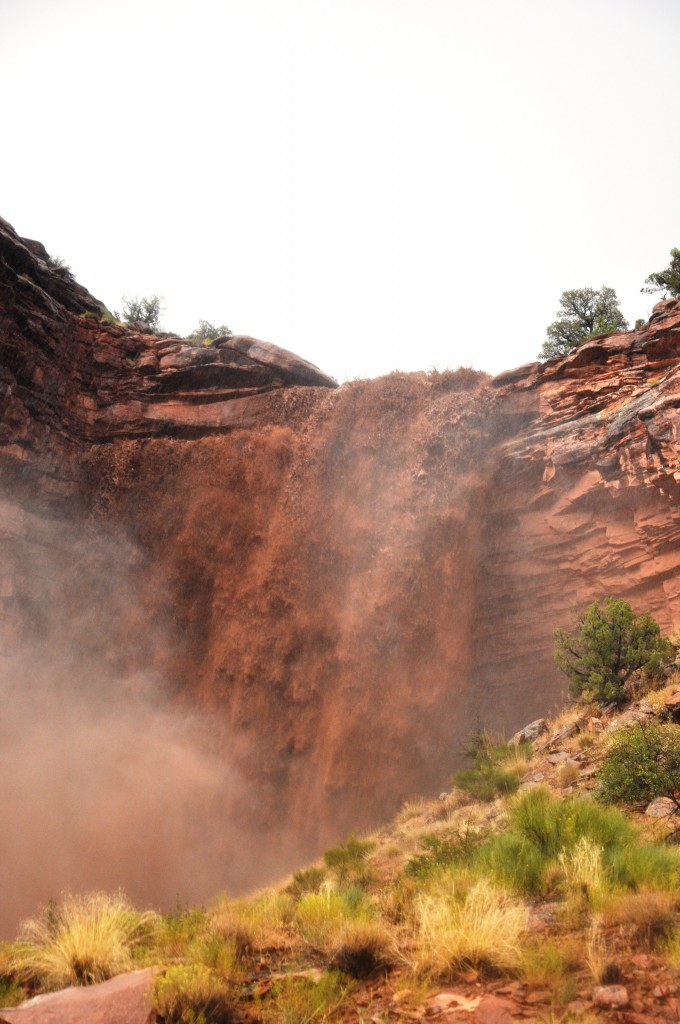We started up the canyon, going north along the road that is sandwiched between the Colorado River and the canyon walls. The storm was now squarely overhead. My boyfriend Greg and I had spent the last month traveling through Colorado and Utah, camping in and exploring some of the country’s most beautiful landscapes. Now we were on our way back East, and just outside of Moab, Utah, it was storming.
For thirty minutes the rain had been coming down. Water had started to collect, shoot across the slick rock, and plummet down the canyon walls to form impromptu, extraordinary waterfalls. It was so raw and changeable that for a moment I wondered if we should continue up the canyon. Had our phones not been on airplane mode, we would have seen the flash flood warnings. Instead, we headed up the canyon, blissfully unaware.
The first ten miles were beautiful. The overcast skies made the colors more magnified. The water’s glare off the wet red rock walls made them look like sheets of ice. Then suddenly, Greg said to stop the car. Right next to us, paralleling the road, a river of moving earth was raging down a previously unnoticed wash.

We got out and walked cautiously through the brush to the banks to see the water close up. Forget “chocolate milk” – the water did not even look like water, it was so heavy with sediment. Raging, the liquid earth sailed past us, through culverts under the roads, and then shot into the Colorado River.
Amazed, we got back in the car and continued up the canyon. We saw an inlet on the other side of the river, where another wash was blasting into the Colorado. The burnt orange floodwater contrasted sharply with the murky blue-black river water. Sediment, logs, and whole bushes were piling up.
As we drove north, we were increasingly driving through shallow pools of water that had started to overflow the curbs and collect on the road. In most places, road engineering was working as designed; washes were swelling, traveling under the roads via the culverts, and washing into the river. Even so, the situation felt only barely under control.
We stopped at a point where two hard-working culverts were diverting a particularly vigorous flood stream. I drove the car over and past the stream, while Greg got out to photograph the water diving under the road. Through the rear view mirror, I watched puzzled as he abruptly stopped taking pictures and started jogging towards the car. Suddenly, the river was over the road. Diverted from a clogged culvert, the water swelled up and over where he had just been standing.

As we watched the large pick-up truck behind us struggle to drive across the water, it was clear we would not have made it were we a minute later. Thus chastened, we started moving a little quicker to higher ground. We passed more shallow puddles and flooding washes, but the roads held.
The grand finale was waiting.
As we came to the last turn, we saw mist coming from around a bend. Greg immediately said, “That’s a waterfall. A big waterfall.” As we turned the bend, it came into view. Torrents of sediment-laden water came barreling out and over the canyon wall to the right of our car, crashing below, flowing under the road and directly into the river. It was so tall, and so violent, and so un-water-like that it gave me a shivery feeling of vertigo. In the two minutes we stopped to take pictures, we ended up completely soaked and caked with dirt from the sediment-mist.

After a month in parched desert, walking past dry, unnoticed washes and dutifully listening to park videos asserting the power and violence of the floodwaters that had formed the canyons, arches, and hoodoos we were admiring, we had borne witness to nature’s power, firsthand.
It was an incredible send-off from a spellbinding landscape.
I initially intended this post to be about the influences of water I saw in my month out West. Nearly every National Park we visited featured water in its park video, highlighting the ways water had formed parks like the Great Sand Dunes in Colorado and the Arches in Utah. In the Black Canyon of the Gunnison, we traveled down to the canyon bottom to see the site where, from 1905-1909, workers dug out the 5.8 mile Gunnison Tunnel to make farming possible in the Uncompahgre Valley; the tunnel is still in use today. In rural Fayette, Utah, a descendent of the original Mormon settlers showed me the spring that his ancestors had found five generations before, and upon which they built their settlement and their farming and hunting livelihoods.
Intellectually, I understood the absolute necessity of water in a desert landscape. I was impressed with the formative power of water to shape landforms, specify wildlife patterns, and dictate human settlements. But not until the flash flood in Moab did I truly FEEL the awe-inspiring power of water.
It was a dramatic reminder that it will take more than data, research, policies, and economic arguments to make meaningful, lasting environmental improvements. Outside of intellectual arguments, people also have to FEEL it. Lately, the environmental movement has tended to focus on the negative – the hurricanes, the droughts, the contaminated water supplies, impending climate change. Yes, these are serious issues and yes, they command headlines and bring attention to our cause. But it is still important that people have positive experiences in the natural world. Let’s not forget what we are fighting to save in the first place – here’s your reminder to go outside and explore.
Edited by Amy Weinfurter.